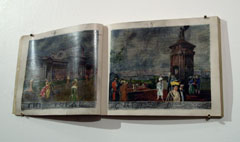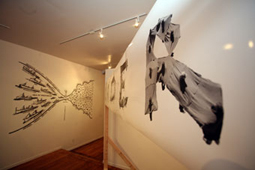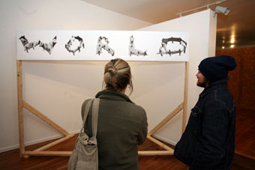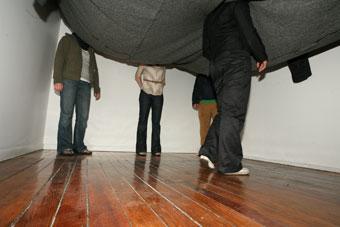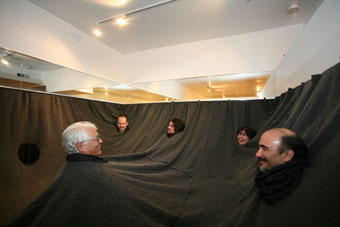—A PERFECT WORLD, 2007
conceptual exhibition and room installation, boots, St. Louis / USA |
|
|
„A
Perfect World“ is a conceptual inquiry of holistic systems in
relation to one‘s role within that very structure. While researching
the 1904 World’s Fair in St. Louis, its overall theme of the
„ideal citizen“ and the impact of technological utopias
around the turn of the century, Beate found a 1894 diagram by businessman
and utopian technocrat King C. Gillette, which outlines the human
drift towards a better future. Gillette’s idea of the world
as a people‘s corporation and his notion of progress depends
on order, organization, intelligence and discipline. Drawn on the
wall of the gallery this image becomes the starting point of the installation
as it divides the exhibition space in two parts: the „sea of
competition for material wealth,“ an unruly, individualist struggle
that leads the viewer through a narrow channel of adversity to the
„sea of progress,“ where science and the arts make up
the key elements of the better world.
Engl questions the humanistic utopia of this idealistic model of evolution
when it is combined with strategic intelligence. In „The narrows“
– set amid the two exhibition spaces – a loudspeaker plays
a speech from the film „Network“ (1976). Arthur Jensen
(Ned Beatty as the head of the Union Broad Casting System) intensely
indoctrinates the newscaster Howard Beale (Peter Finch) with his world
system that is exclusively based on currency: „The world is
a business, Mr. Beale.“
During her residency at Boots Contemporary Art Space, Engl documented
a performance in a public space. The performers spelled out the words
„W-O-R-L-D“ and „O-R-D-E-R“ with grey ponchos
attached to each other. They make physically palpable the gap a between
connected individuals and the system of world order they are illustrating.
Photographs of the performance will be presented in correlation to
the installation, challenging the coherences of their striking content
and questioning which „sea“ drives a more suitable „world
order.“
At the very end of the exhibition space is a small box-like room that
functions as a „think tank.“ To enter the room, the viewer
simply penetrates one of the many ponchos. By popping ones head through
the neck hole, the audience dives into a surreal white cube. The gallery’s
ceiling intensified through wall mirrors and the viewer experiences
a bodiless installation „only for heads.“ This final intellectual
/ spiritual retreat opens up the strict order of the world system
towards a collective meeting room in which people come face to face
or head to head and are forced to interact. |
. |
